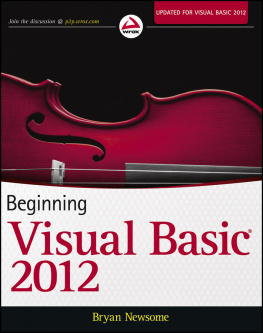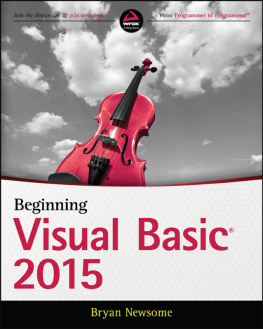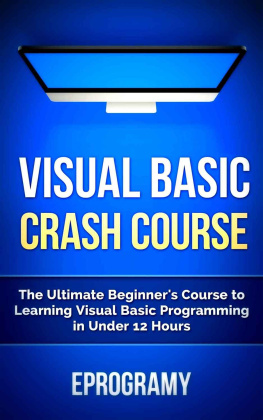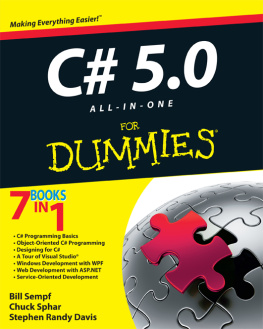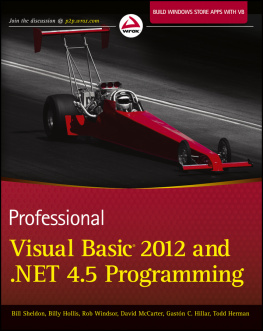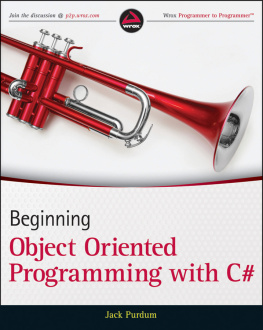
Chapter 1
Welcome to Visual Basic 2012
What You Will Learn in this Chapter
- Using event-driven programming
- Installing Visual Basic 2012
- Touring the Visual Basic 2012 integrated development environment (IDE)
- Creating a simple Windows program
- Using the integrated Help system
Wrox.com Code Downloads for this Chapter
The wrox.com code downloads for this chapter are found at www.wrox.com/remtitle.cgi?isbn=1118311813 on the Download Code tab. The code is in the 311813 C01.zip download.
This is an exciting time to enter the world of programming with Visual Basic 2012 and Windows 8. Windows 8 represents the latest Windows operating system from Microsoft and is packed with a lot of new features to make Windows programming fun. Much has changed in the Windows user interface, and Visual Basic 2012 makes it easy to write professional-looking Windows applications as well as web applications and web services. Haven't upgraded to Windows 8 yet? No worries; Visual Basic 2012 also enables you to write professional-looking applications for previous versions of Windows as well.
The goal of this book is to help you use the Visual Basic 2012 programming language, even if you have never programmed before. You will start slowly and build on what you have learned in subsequent chapters. So take a deep breath, let it out slowly, and tell yourself you can do this. No sweat! No kidding!
Programming a computer is a lot like teaching a child to tie his shoes. Until you find the correct way of giving the instructions, not much is accomplished. Visual Basic 2012 is a language you can use to tell your computer how to do things; but like a child, the computer will understand only if you explain things very clearly. If you have never programmed before, this sounds like an arduous task, and sometimes it can be. However, Visual Basic 2012 offers an easy-to-use language to explain some complex tasks. Although it never hurts to have an understanding of what is happening at the lowest levels, Visual Basic 2012 frees the programmer from having to deal with the mundane complexities of writing Windows applications. You are free to concentrate on solving real problems.
Visual Basic 2012 helps you create solutions that run on the Microsoft Windows operating systems, such as Windows 8, Windows Server 2008, and Windows Phone. If you are looking at this book, you might have already felt the need or desire to create such programs. Even if you have never written a computer program before, as you progress through the Try It Out exercises in this book, you will become familiar with the various aspects of the Visual Basic 2012 language, as well as its foundations in the Microsoft .NET Framework. You will find that it is not nearly as difficult as you imagined. Before you know it, you will feel quite comfortable creating a variety of different types of programs with Visual Basic 2012.
Visual Basic 2012 can also be used to create web applications and web services, as well as mobile applications that can run on Tablet PCs or smartphones. However, you will begin by focusing on Windows applications before extending your boundaries to other platforms.
Event-Driven Programming
A Windows program is quite different from yesteryear's MS-DOS program. A DOS program follows a relatively strict path from beginning to end. Although this does not necessarily limit the functionality of the program, it does limit the road the user has to take to get to it. A DOS program is like walking down a hallway; to get to the end you have to walk down the entire hallway, passing any obstacles that you may encounter. A DOS program would let you open only certain doors along your stroll.
Windows, on the other hand, opened up the world of event-driven programming. Events in this context include clicking a button, resizing a window, or changing an entry in a text box. The code that you write responds to these events. In terms of the hallway analogy: In a Windows program, to get to the end of the hall you just click the end of the hall. The hallway itself can be ignored. If you get to the end and realize that is not where you wanted to be, you can just set off for the new destination without returning to your starting point. The program reacts to your movements and takes the necessary actions to complete your desired tasks.
Another big advantage in a Windows program is the abstraction of the hardware, which means that Windows takes care of communicating with the hardware for you. You do not need to know the inner workings of every laser printer on the market just to create output. You do not need to study the schematics for graphics cards to write your own game. Windows wraps up this functionality by providing generic routines that communicate with the drivers written by hardware manufacturers. This is probably the main reason why Windows has been so successful. The generic routines are referred to as the Windows application programming interface (API), and most of the classes in the .NET Framework take care of communicating with those APIs.
Before Visual Basic 1 was introduced to the world in 1991, developers had to be well versed in C and C++ programming, as well as the building blocks of the Windows system itself, the Windows API. This complexity meant that only dedicated and properly trained individuals were capable of turning out software that could run on Windows. Visual Basic changed all that, and it has been estimated that there are now as many lines of production code written in Visual Basic as in any other language.
Visual Basic changed the face of Windows programming by removing the complex burden of writing code for the user interface (UI). By allowing programmers to draw their own UI, it freed them to concentrate on the business problems they were trying to solve. When the UI is drawn, the programmer can then add the code to react to events.
Visual Basic has also been extensible from the very beginning. Third-party vendors quickly saw the market for reusable modules to aid developers. These modules, or controls, were originally referred to as VBXs (named after their file extension). Prior to Visual Basic 5, if you did not like the way a button behaved, you could either buy or create your own, but those controls had to be written in C or C++. Database access utilities were some of the first controls available. Version 5 of Visual Basic introduced the concept of ActiveX, which enabled developers to create their own ActiveX controls.
When Microsoft introduced Visual Basic 3, the programming world changed significantly. You could build database applications directly accessible to users (so-called front-end applications) completely with Visual Basic. There was no need to rely on third-party controls. Microsoft accomplished this task with the introduction of Data Access Objects (DAOs), which enabled programmers to manipulate data with the same ease as manipulating the user interface.
Versions 4 and 5 extended the capabilities of version 3 to enable developers to target the new Windows 95 platform. They also made it easier for developers to write code, which could then be manipulated to make it usable to other language developers. Version 6 provided a new way to access databases with the integration of ActiveX Data Objects (ADOs). The ADO feature was developed by Microsoft to aid web developers using Active Server Pages (ASP) to access databases. All the improvements to Visual Basic over the years have ensured its dominant place in the programming worldit helps developers write robust and maintainable applications in record time.
Next page
